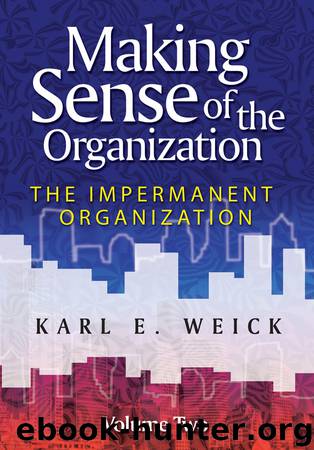Making Sense of the Organization Volume 2 by Karl E. Weick

Author:Karl E. Weick
Language: eng
Format: epub
Publisher: John Wiley & Sons
Published: 2011-12-05T16:00:00+00:00
The Nature of Organized Sensemaking: Viewed Prospectively
Considering the modest amount of empirical work on sensemaking that has accumulated so far, the question of “future directions” pretty much takes care of itself. Almost any kind of work is likely to enhance our understanding of a largely invisible, taken-for-granted social process that is woven into communication and activity in ways that seem to mimic Darwinian evolution. We briefly discuss institutionalization, distributed sensemaking, power, and emotion to illustrate a few of the many ways in which present thinking about sensemaking might be enhanced.
Sensemaking and Institutional Theory
We have treated organizing as activity that provides a more ordered social reality by reducing equivocality. A crucial question is whether that reality gets renegotiated in every social interaction or whether, as Zucker (1983) puts it, “institutionalization simply constructs the way things are: alternatives may be literally unthinkable” (p. 5). The tension inherent in these otherwise “cool” positions is evident when Czarniawska (2003, p. 134) observes that “Intentional action never leads to intended results, simply because there is a lot of intentional action directed at different aims in each time and place. Institutionalization, like power, is a post factum description of the resultant of all those efforts combined with the random events that accompanied them.”
Discussions of sensemaking often include words like “construct,” “enact,” “generate,” “create,” “invent,” “imagine,” “originate,” and “devise.” Less often do we find words like “react,” “discover,” “detect,” “become aware of,” or “comply with.” This asymmetry suggests that people who talk about sensemaking may exaggerate agency and may be reluctant to assume that people internalize and adopt whatever is handed to them, as Zucker suggests. An example of such exaggeration might be the statement, “sensemaking is the feedstock for institutionalization” (Weick 1995, p. 36). Institutionalists might well argue that the causal arrow in this assertion points in the wrong direction. The causal arrow neglects evidence showing that organizational members are socialized (indoctrinated) into expected sensemaking activities and that firm behavior is shaped by broad cognitive, normative, and regulatory forces that derive from and are enforced by powerful actors such as mass media, governmental agencies, professions, and interest groups (Lounsbury and Glynn 2001). In other words, “no organization can properly be understood apart from its wider social and cultural context” (Scott 1995, p. 151).
These diverse positions can begin to be reconciled if we focus on mechanisms that link micro-macro levels of analysis and if we pay as much attention to structuring and conversing as we do to structures and texts. One way to further such reconciliation is to follow the lead of Hedstrom and Swedberg (1998), who argue that when we want to explain change and variation at the macrolevel of analysis, we need to show “how macro states at one point in time influence the behavior of individual actors, and how these actions generate new macro states at a later time” (p. 21). Sensemaking can provide micromechanisms that link macrostates across time through explication of cognitive structures associated with mimetic processes, agency, the mobilization of resistance, alternatives to conformity such as independence, anticonformity, and uniformity (Weick 1979, p.
Download
This site does not store any files on its server. We only index and link to content provided by other sites. Please contact the content providers to delete copyright contents if any and email us, we'll remove relevant links or contents immediately.
Bad Blood by John Carreyrou(5760)
Principles: Life and Work by Ray Dalio(5315)
Rich Dad Poor Dad by Robert T. Kiyosaki(5140)
Management Strategies for the Cloud Revolution: How Cloud Computing Is Transforming Business and Why You Can't Afford to Be Left Behind by Charles Babcock(4127)
The Confidence Code by Katty Kay(3560)
Thinking in Bets by Annie Duke(3526)
American Kingpin by Nick Bilton(2966)
Delivering Happiness by Tony Hsieh(2917)
Playing to Win_ How Strategy Really Works by A.G. Lafley & Roger L. Martin(2914)
Project Animal Farm: An Accidental Journey into the Secret World of Farming and the Truth About Our Food by Sonia Faruqi(2654)
Brotopia by Emily Chang(2586)
I Live in the Future & Here's How It Works by Nick Bilton(2520)
Mastering Bitcoin: Programming the Open Blockchain by Andreas M. Antonopoulos(2504)
The Content Trap by Bharat Anand(2488)
The Power of Habit by Charles Duhigg(2482)
The Marketing Plan Handbook: Develop Big-Picture Marketing Plans for Pennies on the Dollar by Robert W. Bly(2408)
The Tyranny of Metrics by Jerry Z. Muller(2397)
Building a StoryBrand by Donald Miller(2356)
Applied Empathy by Michael Ventura(2323)
